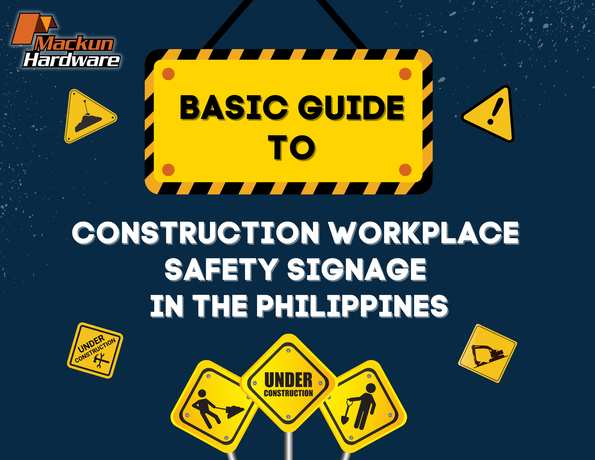Heads up!
Limited stock on popular items.
Verify availability before you order!
- No products in the cart.
Heads up!
Limited stock on popular items.
Verify availability before you order!

Construction sites are hazardous environments. With heavy equipment, elevated work areas, and constant movement, the risk of accidents is high if safety protocols aren’t strictly followed. One of the simplest yet most effective ways to mitigate risk is the proper use of safety signage. In the Philippines, safety signs aren’t just best practices—they’re legal requirements under the Occupational Safety and Health Standards (OSHS) enforced by the Department of Labor and Employment (DOLE).
We’ll explain the basics of construction workplace safety signage in the Philippines—what they are, the different types of safety signs, and how to use them effectively on-site.

Construction safety signs are visual tools that warn you of nearby hazards to ensure the safety of workers, visitors, and passersby. They serve as visible reminders of what must be done or avoided in a high-risk setting.
Safety signages are mandatory under Department Order No. 13, Series of 1998, specifically Section 9, which requires their use to indicate hazards on construction sites.
Safety signage in Philippine construction sites typically falls under several categories under DOLE guidelines. Keep in mind that the colors and designs described in this guide are based on international standards and DOLE guidelines, but actual signage appearances may vary.
One of the most famous signs, these indicate potential hazards that might not be immediately obvious. For example:
“Caution: Falling Debris
“Slippery When Wet”
“Open Excavation Ahead”

Usually marked with yellow backgrounds and black text or symbols, warning signs aim to alert people to proceed with care.
These signs tell workers what must be done. Common examples include:
“Hard Hat Area”
“Wear Ear Mufflers/Plugs”
“Use Safety Shoes”

They’re typically blue and white and indicate compulsory protective measures.
Used to restrict actions that could pose a danger. Examples include:
“No Entry Without PPE”
“No Smoking”
“No Unauthorized Personnel”

These signs are often white with red borders and a diagonal slash across a black pictogram.
These provide directions in case of emergencies. For example:
“Emergency Exit”
“First Aid Station”
“Fire Extinguisher”

Typically featuring red, green, or white text or symbols, these signs must always remain clearly visible and easily accessible.
To be effective, construction safety signs must meet several criteria:
Visibility: Signs should be clearly visible from a reasonable distance, even in low-light conditions. Use reflective materials if needed.
Durability: Signs must withstand outdoor conditions like rain, heat, and dust.
Placement: Install signs at eye level and near the associated hazard or instruction.
Standardization: Use consistent colors, fonts, and symbols for each type of signage to avoid confusion.
Language: In the Philippines, use English, Filipino, or the local dialect as needed to ensure everyone understands the message.
Construction workplace safety signage in the Philippines is legally mandatory and saves lives. Clear, visible signs act as the first line of defense in accident prevention. Whether you’re managing a small project or overseeing a major build, always make sure your safety signs are properly installed and understood by everyone on-site.
Make sure everyone follows the safety signs. We have a broad variety of personal protective equipment (PPEs) to help you stay compliant with DOLE safety standards.
We hope this guide was helpful! If you need more assistance, our team at Mackun Hardware is always ready to help.
Check out our wide assortment of personal protective equipment here.

For inquiries and orders you may visit or contact us:
Address: RW Building, Sergio Osmeña Street Cagayan de Oro City, Misamis Oriental 9000
Contact No. : +63 956 037 2805
| Product | Price | Quantity | Options | |||||
|---|---|---|---|---|---|---|---|---|
| Features |
| Availability: |
| Price |
| Options |
| Actions |
